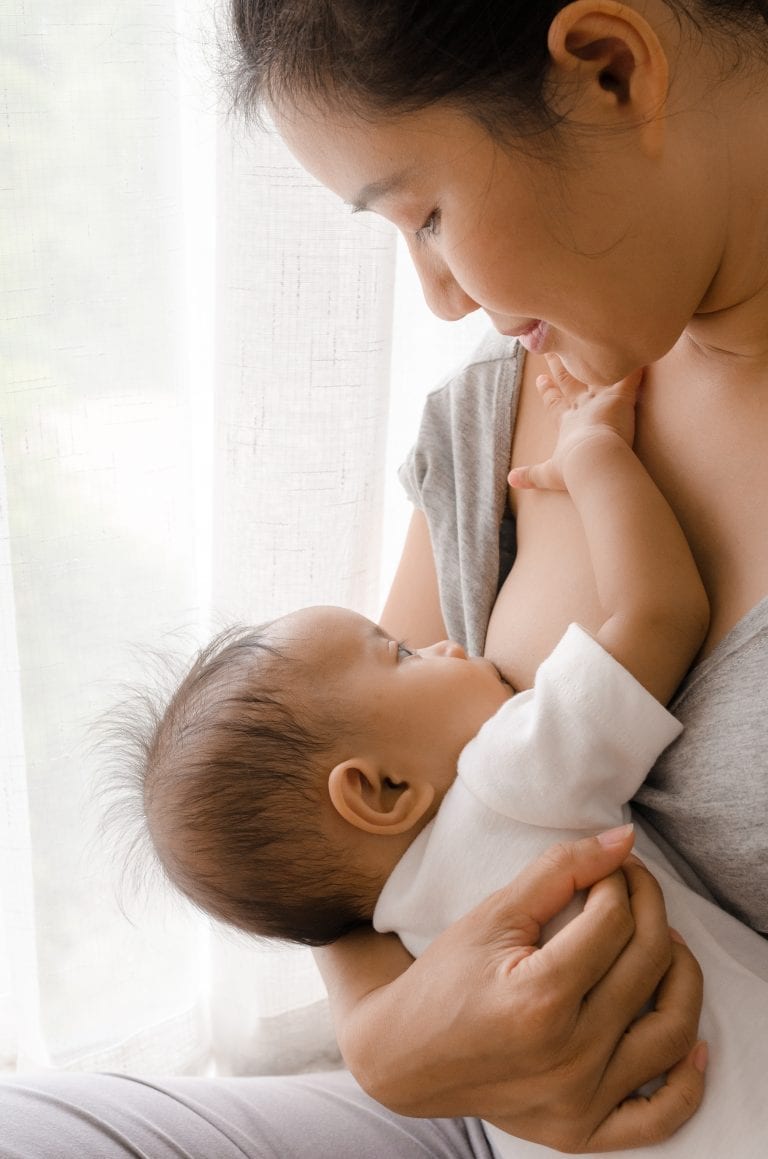Changes to your breasts begin even before you know you are pregnant! They can be startling. But, don’t worry, these breast changes are normal with pregnancy. Here’s what you can expect during and after your pregnancy:
1st trimester: Breast and nipple tenderness is an early sign of pregnancy. Your breasts are getting larger because of the extra hormones and blood flow of pregnancy. Even the surface veins of your breast make darken and become more visible. Your breasts may feel tender or painful, similar to how your breasts feel before your period.
The nipples and areola (area around the nipples) may darken in color. You may also see small bumps emerge around the nipple, which is a good thing! These Montgomery’s Tubercules (also called areolar glands) produce antibacterial oils that moisturize, protect and help prevent skin infection.
2nd trimester: You may need bras with larger cup sizes; always go for support, comfort and the possibility of needing a large cup size as you continue through pregnancy—some moms even opt to wear nursing bras in pregnancy because they can accommodate changes in your breast size when nursing as well. Your body will start making colostrum—that immuno-rich milk that will sustain your baby in their first days!
3rd trimester: Your breasts likely feel full and heavy; you may even notice stretch marks. These happen when the skin can’t stretch enough to accommodate the rapid growth. Moisturizing can help prevent itching and dryness but not stretch marks, sorry!
Breast Changes When Breastfeeding
Your baby will first receive colostrum from your breasts. A day or two later, your milk will come in. Post-pregnancy, as your estrogen and progesterone levels decline, the milk-making hormone prolactin will rise to begin making milk for baby. Milk production is a supply-and-demand system, the more milk that’s removed from the breasts, the more the body makes. Try to nurse baby on each breast at each feeding, and nurse as often and for as long as baby is hungry to build a strong milk supply.
If the fullness in your breasts becomes uncomfortable, or if the tissue gets stretched so tight it’s difficult for baby to latch, hand express or pump milk from your breasts to relieve this discomfort called engorgement.
Sex & Your Postpartum Breasts
Your partner may be unsure of how to handle your breasts postpartum; reassure them there’s no problem with touching or stimulating your breasts and nipples. If it feels good, go for it! If it doesn’t feel good, don’t involve the breasts or nipples in sex play right now.
You may find your nipples are extra sensitive and delicate during lactation. Talk to your partner about what you want and don’t want. Also know that while you’re making milk, your estrogen levels remain low, which means little to no vaginal lubrication with arousal, so be sure to have a water-based lubricant handy.
Be prepared for the fact that you may leak breast milk with any nipple or breast stimulation, especially with orgasm. The hormone that allows milk to let down when your baby nurses is the same one that skyrockets with orgasm.
You may even notice lumps in your breasts after baby’s birth; most often, these are either milk-filled cysts or benign breast tumors. Talk to your healthcare provider if they feel hard or don’t resolve within a day or so on their own.
Your Breasts after Nursing
Once you wean your baby, you’ll stop making milk. Your breasts will likely become suppler yet less full than before you were pregnant. You may return to the same bra size or you may need a different size. You may be worried about the changed appearance of your breasts. This is a common and normal concern. This is a time to be kind to your body. After all, your body has worked hard to develop, protect and nourish your baby!
Manage Engorgement
- Nurse baby as often as the baby is interested (every 2-3 hours) in the first 4-5 days after birth
- Hand express or pump a little milk before each feeding can help soften the tissue and allow for easier latching
- Warm wash clothes placed to the breast or a warm shower can help ease fullness as well
If you’re Not Breastfeeding
Even if you’re not planning on breastfeeding, your body will still try to make milk for your baby. Your body begins to learn that since you’re not nursing baby, you don’t need to make milk, and it begins to secrete prolactin inhibiting factor (PIF) to stop milk production.
As long as you avoid expressing milk from your breasts, your body will shut down lactation in about 7-10 days. If you’ve been breastfeeding, though, it will take longer for your body to stop making milk. Use the supply-and-demand nature of milk production to discourage your breasts from making milk:
- Wear a comfortable, supportive, snug bra at all times until milk production stops
- Avoid any nipple or breast stimulation that would cause your breasts to release milk as this will encourage your body’s milk-making
- Cool your breasts with cold compresses to ease discomfort (a bag of frozen vegetables or a sports cool pack wrapped in a damp cloth)
- Take an over-the-counter pain reliever as needed like acetaminophen or ibuprofen for pain during fullness






Comments are closed.